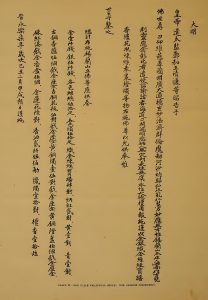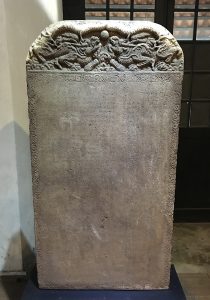OB03138 Anurādhapura Slab of Khudda-Pārinda
IN03167 Anurādhapura Slab Inscription of Khudda-Pārinda
This inscription is engraved across the front, one side and the back of a stone slab now preserved in the Archaeological Museum at Anurādhapura. Senarath Paranavitana recorded that the slab was said to have been discovered in the area of the Abhayagiri Vihāra in Anurādhapura. He also noted that it had been included in the list of lithic inscriptions from Nuvara-kalāviya exhibited at Anurādhapura in the Archaeological Survey of Ceylon Annual Report for 1911–12 (p. 73, no. 16). He was unable to find any other references to the slab giving further details about its provenance. The inscription registers some donations made to a Buddhist monastery by the queen of a king called Badadasa Ḷa-Parideva. Neither the name of the monastery nor that of the queen is preserved. However, it seems that the final part of the monastery’s name may have been la, suggesting that it was not the Abhayagiri Vihara, in which case we may perhaps assume that the slab was originally situated elsewhere and brought to this vihara at a later date, possibly for some architectural purpose. As for the king’s name, Paranavitana argues that Parideva may be taken as a clerical error for or variant of Paridadeva – a combination of the personal name Pārinda and the suffix deva, which could be applied to the appellation of any royal personage. According to the chronicle, Pārinda was one of the six Tamil rulers who occupied the throne of Anurādhapura in the fifth century A.D., prior to the accession of Dhātusena. Since Ḷa in Sinhalese means ‘tender’ or ‘young’, Ḷa-Pari(da)deva can be understood as ‘Pārindadeva the Younger’, which equates to Khudda Pārinda (the lesser Pārinda), the name given in the chronicle to king Pārinda’s younger brother and successor. Hence Paranavitana attributes this inscription to Khudda Pārinda, the Tamil king who reigned from 437 to 452 (or from 498 to 513, according to Wickremasinghe’s chronology).
OB03135 Batalagoḍa-Väva Slab
IN03163 Batalagoḍa-Väva Slab Inscription
The inscription is engraved on a stone slab, which was discovered near Batalagoḍa-väva, an ancient irrigation reservoir situated about eight miles from Kuruṇǟgala on the road to Dam̆bulla. The slab has been broken into several fragments, some of which are missing. The remaining pieces have been joined and the gaps filled with cement by an overzealous restorer, who – not content with merely putting together what was left of the record – also guessed at what the missing portions of the text may have said and inscribed his suggestions on the cement. Most of this guesswork is unacceptable and has been omitted from the edition of the text published here.
The Batalogoda reservoir was restored by the Ceylon Government around the turn of the twentieth century. Henry Parker was in charge of the restoration work and gave a detailed description of the tank, including an account of the present inscription, in his Ancient Ceylon (1909: 254, 397–400). He was presumably the one responsible for the repair of the slab.
The inscription is dated in the fifth year of Queen Kalyāṇavatī, who ascended the throne in 1202 A.D. It records the repairs effected to the Batalagoḍa-väva and the benefactions made to a neighbouring shrine by an officer (adhikāri) named Cūḍāmaṇi. The part of the inscription containing the titles of this officer has been lost. The general Lakvijaya Ābo Senevinā is also mentioned, though the nature of his involvement is not clear as the section of inscription where his name occurs is very fragmentary. It may, however, be surmised that it was at his command that Cūḍāmaṇi carried out the works at Batalgoḍa. This general is obviously the same as Lakvijaya Siṅgu Senevi Ābonā, who placed Sāhasmalla on the throne. The same individual is called by the name ‘Āyuṣmat’ in the Sanskrit inscription of Sāhasmalla at Poḷonnaruva (IN03099) and therefore can also be identified with the general called Āyasmanta in the Mahāvaṁsa, who placed Kalyāṇavatī – the monarch of the present inscription – on the throne. Clearly he was a very powerful figure and a veritable king-maker in early thirteenth century Sri Lanka.
OB03134 Poḷonnaruva Inscribed Slab of Sundara-Mahādevī
Rajavesyabhujanga Mandapa, Polonnaruwa. Photographed before (above) and after (below) restoration in 1931 by the Archaeological Survey of Ceylon. Images published in: Kern Institute. (1933). Annual Bibliography of Indian Archaeology for the year 1931. Leyden: E. J. Brill, plate V.
IN03162 Poḷonnaruva Fragmentary Slab Inscription of Sundara-Mahādevī
This inscription is engraved on a stone slab discovered in 1931 by the Archaeological Department during the restoration of the ruined maṇḍapa built on a three-tiered platform near the Royal Palace of Parākramabāhu I at Poḷonnaruva. This maṇḍapa was identified by A. M. Hocart with the Rājaveśyā-bhujaṅga-maṇḍapa, mentioned in the Mahāvaṁsa as having been built by Parākramabāhu I. In the course of the Archaeological Department’s restoration work, it was discovered that the builders of this structure had utilised several earlier inscribed stones for the steps, mouldings and coping stones. Evidence was also found that the building had been substantially repaired at a later date, probably during the reign of Parākramabāhu II. It is therefore not certain whether the inscribed stones were used in the initial construction of the building or whether they were introduced as part of the subsequent repairs. The slab bearing the present inscription was used for the coping on the eastern side of the lowest tier of the platform. A large part of the inscription was effaced, perhaps deliberately, when the slab was utilised for this new purpose. Originally, the record must have consisted of around 45 lines but now only the first seven are legible. These lines are not enough to determine the subject matter and purpose of the inscription. The first two lines contain a Pāli stanza eulogising a thera named Ānanda, who is said to have had some connection with the Buddhist Church of Tambaraṭṭha, possibly referring to a place in the Coḷa country in Southern India or to Nakhon Si Thammarat in the Malay Peninsula. The next five lines introduce us to Sundaramahādevī, the queen of Vīkramabāhu I (r. 1111–1132 A.D.), who was the son of Vijayabāhu I (r. 1056–1111 A.D.).
OB03128 Gaḍalādeṇiya Slab-Pillar
Gadaladeniya Vihara, Kandy, Sri Lanka
IN03155 Gaḍalādeṇiya Slab-Pillar Inscription
This inscription is engraved on a slab pillar, which now stands outside the main entrance of the Gaḍalādeṇiya Vihārē, a foundation of the fourteenth century situated in Uḍunuvara of Kandy District. The pillar was set up in its present position by H. C. P. Bell, Archaeological Commissioner, who found it inside the temple. All four faces of the pillar are inscribed. On the front of the slab is a record dated in the fifth year of king Siri San̆gbō Śrī Jayavīra Parākrama Bāhu, which grants an amnesty to Mēṇavara Tuṇayan, nephew of the ǟpā Parākrama Bāhu of Doḍamvela, and the people of the Five Countries, on the reduction of the Hill Country then recently effected before the Coronation Festival held on the twelfth of the bright half of Vesak. This text is preceded on one of the narrow sides of the slab by the word Siddhi engraved beneath the sun and moon, a cakra and conch shell. On the reverse of the slab, continued on the other narrow side, is the undertaking of the rebels to be faithful to His Majesty; their leader is here called Mēṇavara Tuṇayārun. Codrington tentatively suggests that the king Siri San̆gbō Śrī Jayavīra Parākrama Bāhu of this inscription may have been Parākrama Bāhu IX, whose coronation took place in 1509 and whose reduction of the Hill Country is recorded in the Rājāvaliya. This would make the date of the inscription 30 September 1513.
IN03152 Galle Trilingual Stele – Chinese Inscription

Galle (Sri Lanka). Stele of Zheng He (鄭和), transcription of Chinese portion. (Zenodo).
The inscription is engraved on a stone slab discovered in 1911 by H. F. Tomalin, the Provincial Engineer at Galle, in a culvert near the turn to Cripps Road within that town and afterwards moved to the Colombo Museum. The slab features inscriptions in three different languages, enclosed within a floral border: Tamil (top-left, IN03150), Persian (bottom-left, IN03151) and Chinese (right). The Chinese inscription is dealt with here.
Following the discovery of the slab, the Chinese inscription was transcribed and translated by Edmund Backhouse. Like the Tamil inscription, it is dated in the second month of the seventh year of Yongle (永樂), the Chinese emperor whose reign began in 1403. The text features praise and offerings dedicated by the Chinese emperor, through his envoys Ching-Ho and Wang Ch’ing Lien, to the Buddha. The other two inscriptions on the slab feature similar lists of offerings but the beneficiary is different in each case, being a Hindu cult deity in the Tamil text and an Islamic saint or shrine in the Persian. It therefore appears that, when the Chinese arrived in Sri Lanka, they made gifts of equal value to several different religious traditions of the region and registered these gifts on the same stele.

